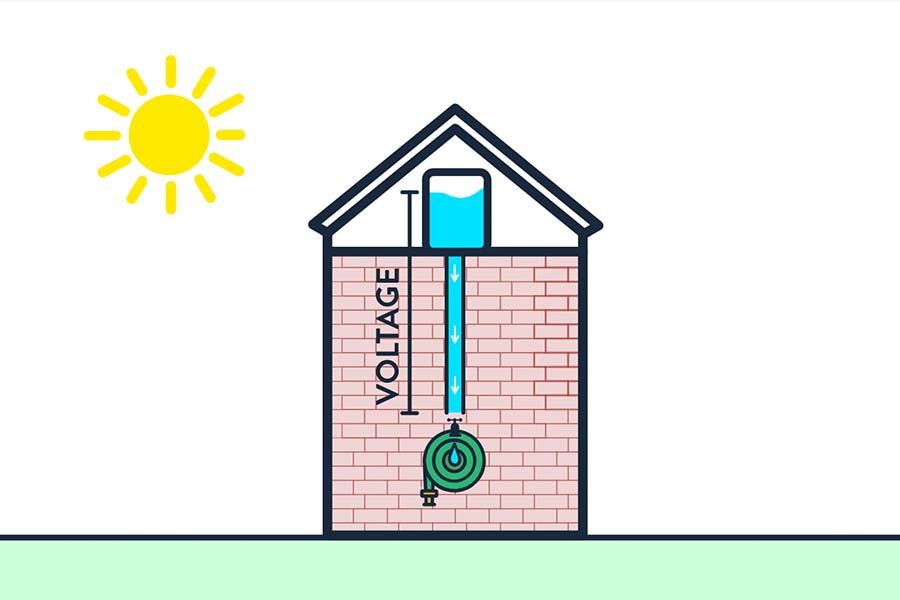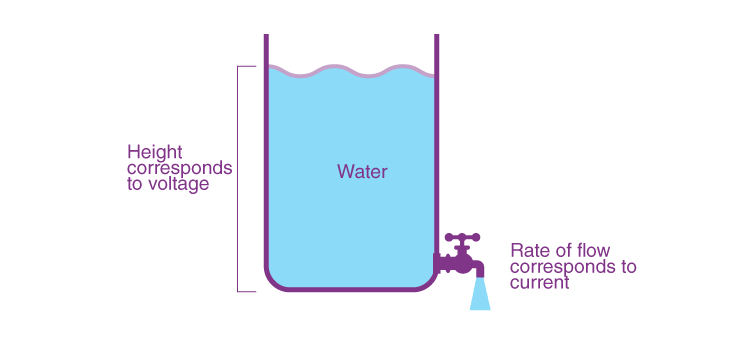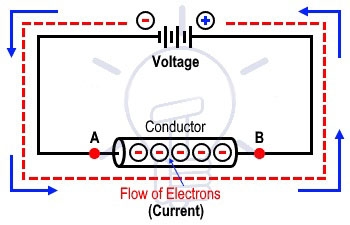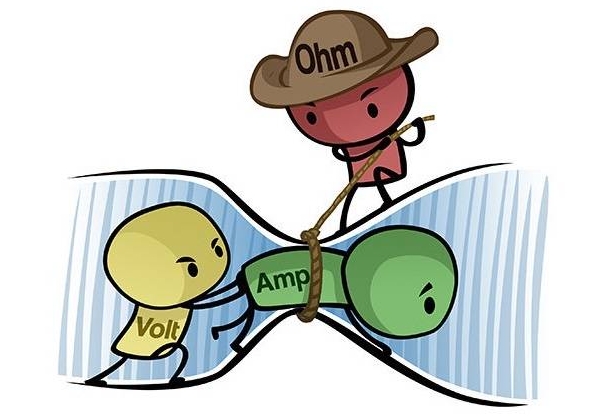Spanning en stroom zijn fundamentele concepten in de elektrotechniek.
Begrijpen wat het verschil is tussen volt en stroom is cruciaal voor een diepgaand begrip van de werking van elektriciteit.
In dit artikel wordt de kennis van spanning en batterijstroom onderzocht, met definities en verschillen tussen de huidige & Spanning.
Het zal zeer nuttig zijn voor mensen in nood.
Wat is spanning?
Accuspanning verwijst naar de elektromotorische kracht (EMV) gegenereerd door een batterij, ook bekend als het potentiaalverschil of potentiaalverschil.
Spanning wordt gebruikt om de potentiële energie te meten die een eenheidslading uitdrukt, in wezen de kracht die stroom door een geleider voortstuwt.
De eenheid van spanning is volt (V), gedefinieerd als de energie van één joule per coulombische lading.

Spanning kan worden vergeleken met de waterdruk van een waterleiding.
Net zoals water van gebieden met hoge waterdruk naar gebieden met lage waterdruk stroomt, stroom vloeit ook van hoogspanningspunten naar laagspanningspunten.
Hoe groter het spanningsverschil, hoe meer energie beschikbaar is om de stroom door het circuit te sturen.
Als je het over accuspanning hebt, we onderzoeken feitelijk het potentiële energieverschil tussen de positieve en negatieve elektroden van de batterij.
Dit verschil genereert een elektrisch veld, wat de stroom van elektronen bevordert.
Zo wordt de overdracht van elektrische energie van de batterij naar de aangesloten apparaten bereikt, het leveren van de nodige energie voor elektronische apparaten.
Wat is batterijstroom?
Stroom verwijst naar de beweging van lading in een circuit, die de hoeveelheid lading definieert die per seconde door een bepaald punt in het circuit gaat.
De stroom in een circuit wordt gegenereerd door de beweging van elektronen (negatief geladen deeltjes).
Deze elektronen stromen door het circuit onder invloed van het spanningsverschil, van de negatieve pool van de spanningsbron naar de positieve pool, een gesloten circuit vormen.
Zo wordt energieoverdracht bereikt en wordt stroom geleverd aan elektronische componenten in het circuit.

Elektrische stroom kan worden vergeleken met de snelheid van de waterstroom in een pijpleiding.
De snelheid van de waterstroom wordt gemeten in gallons per minuut, terwijl de snelheid van elektrische stroom wordt gemeten in ampère.
De eenheid van stroom is ampère (EEN), meestal vertegenwoordigd door het symbool "I".
De snelheid waarmee stroom door een circuit gaat, hangt af van de aangelegde spanning en de weerstand van het circuit.
De grootte van de stroom is recht evenredig met de spanning (V) in het circuit en omgekeerd evenredig met de weerstand (R) in het circuit.
Hoe hoger de spanning of hoe lager de weerstand, hoe groter de stroom.
Wat is het verschil tussen spanning en stroom?

Hoewel spanning en stroom met elkaar verbonden zijn, ze spelen verschillende rollen in elektrische systemen.
Het beheersen van het verschil tussen deze twee is cruciaal voor een dieper begrip van de werkingsprincipes en functies van circuits.
Hier is het verschil tussen de huidige & Spanning:
Definitie verschil:
Spanning is een maatstaf voor de potentiële energie per ladingseenheid, bekend als het potentiaalverschil.
Het is de drijvende kracht die de stroom van elektrische stroom veroorzaakt, gemeten in volt (V).
Stroom is de daadwerkelijke beweging van lading in een circuit, gemeten in ampère (EEN).
symbool representatie:
Spanning wordt gewoonlijk weergegeven door "V".
Huidige wordt gewoonlijk vertegenwoordigd door "I".
Fysieke eigendom:
Spanning is een scalair, met alleen grootte en geen richting.
Stroom is een vector, met zowel omvang als richting.
Functionele rol:
Spanning is de drijvende kracht die stroom door een elektrisch circuit voortstuwt.
Het levert energie voor de beweging van elektronen in circuits.
Stroom is de manifestatie van de feitelijke stroom van elektronen.
Meetinstrument:
De spanning wordt gemeten via een voltmeter.
De stroom wordt gemeten via een ampèremeter.
Afhankelijkheid:
De spanning is onafhankelijk van het circuit, terwijl de grootte van de stroom wordt beïnvloed door de weerstand van het circuit.
Het zijn verschillende fysieke grootheden.
Spanning genereert een elektrisch veld, wat de stroomstroom bevordert.
De grootte van de stroom hangt af van de aangelegde spanning en de weerstand van het circuit.

Nu begrijp je wat het verschil is tussen volt en stroom.
Wat u vervolgens zult leren, is hoe stroom en spanning verband houden en hoe ze elkaar beïnvloeden.
De wet van Ohm:
Wiskundig, De wet van Ohm wordt uitgedrukt als I=V/R
I vertegenwoordigt actueel (eenheid: ampère, EEN)
V vertegenwoordigt spanning (eenheid: volt, V)
R vertegenwoordigt weerstand (eenheid: ohm, Oh)
De wet van Ohm verduidelijkt de fundamentele relatie tussen spanning, huidig, en weerstand.
Het geeft aan dat de stroom in een circuit evenredig is met de spanning en omgekeerd evenredig met de weerstand.
Proportionele relatie:
Via de wet van Ohm, je zult weten dat er een proportioneel verband bestaat tussen spanning en stroom.
Via de wet van Ohm, je zult weten dat er een proportioneel verband bestaat tussen spanning en stroom.
Bijvoorbeeld, als de spanning over het circuit verdubbelt terwijl de weerstand constant blijft, de stroom die door het circuit vloeit, zal ook verdubbelen.
De invloed van weerstand:
De verandering in weerstand zal de relatie tussen spanning en stroom veranderen.
Wanneer de spanning constant is, als de weerstand toeneemt, de stroom zal afnemen.
Omdat een hogere weerstand de stroom van elektronen beperkt.
Integendeel, als de spanning constant blijft en de weerstand afneemt, de stroom zal toenemen.
Omdat de lagere weerstand de belemmering van de elektronenstroom vermindert.
Vermogensberekening:
Spanning en stroom zijn cruciaal voor het berekenen van het vermogen in een circuit.
Vermogen wordt gemeten in watt (W) en is het product van spanning en stroom: P=V * I.
Deze relatie benadrukt het belang van spanning en stroom bij het bepalen van het energieverbruik of de transmissie van een circuit.
Serie- en parallelle circuits:
In een serieschakeling, De spanning wordt verdeeld over verschillende componenten, maar de stroom van het hele circuit is hetzelfde.
In een serieschakeling, De spanning wordt verdeeld over verschillende componenten, maar de stroom van het hele circuit is hetzelfde.
In een parallelschakeling, de spanning van elke tak is hetzelfde, terwijl de totale stroom over de verschillende componenten wordt verdeeld.
De som van de stromen in elke tak is gelijk aan de totale stroom die het circuit binnenkomt.
Conclusie
samengevat, spanning en stroom zijn belangrijke fundamentele concepten waaruit een elektrisch systeem bestaat.
Spanning meet de potentiële energie van een eenheidslading, terwijl stroom de ladingsstroom in een circuit beschrijft.
Het beheersen van de verschillen in spanning en stroom en hun interacties is essentieel voor het ontwerp en de analyse van circuits, voeding voor elektronische apparaten, en het garanderen van de elektrische veiligheid.

Veelgestelde vragen
Zal er nog steeds spanning zijn zonder stroom??
In werkelijkheid, spanning kan onafhankelijk van stroom bestaan.
Spanning is een maat voor het potentiaalverschil, wat het potentieel vertegenwoordigt om de stroom te sturen.
Echter, zonder dat een gesloten circuit een pad biedt, ook als er een spanningsverschil is, elektronen kunnen niet stromen.
Deze kant op, er wordt geen stroom gegenereerd.
In het kort, spanning is een noodzakelijke voorwaarde voor het stromen van stroom, maar de stroom van stroom vereist ook een volledig circuitpad.
Wat is het verschil tussen de concepten stroom en elektriciteit?
Stroom verwijst specifiek naar de stroom van elektrische lading, gemeten in ampère (EEN).
Elektriciteit is een breder concept dat wordt gebruikt om verschillende verschijnselen te beschrijven die verband houden met de stroom van elektrische ladingen.
Stroom verwijst naar de stroom van elektronen in een circuit, terwijl elektriciteit het hele scala aan elektrische verschijnselen en hun toepassingen omvat.
Welke problemen kunnen hoogspanning veroorzaken??
Wanneer de spanning in het circuit het normale bereik overschrijdt, het kan een reeks negatieve effecten veroorzaken.
Een te hoge spanning kan ervoor zorgen dat circuitcomponenten oververhit raken, schade, en zelfs een risico op elektrische schokken met zich meebrengen.
Als het een hoogspanningsbatterij is, het kan tijdens het gebruik meer potentiële risico's met zich meebrengen.
De veiligheid van GycxSolar lithiumbatterijen is gecertificeerd door gezaghebbende testinstituten, waardoor het uw betrouwbare keuze is.
